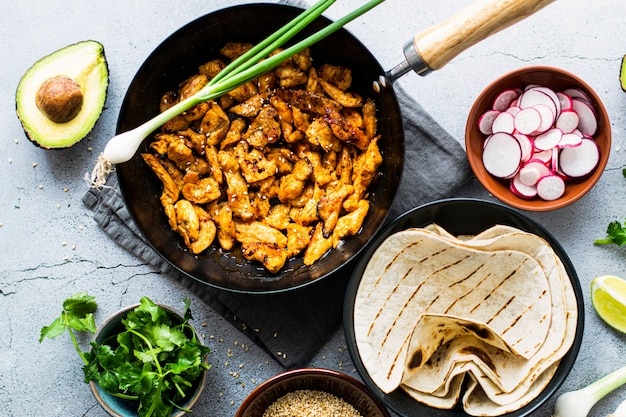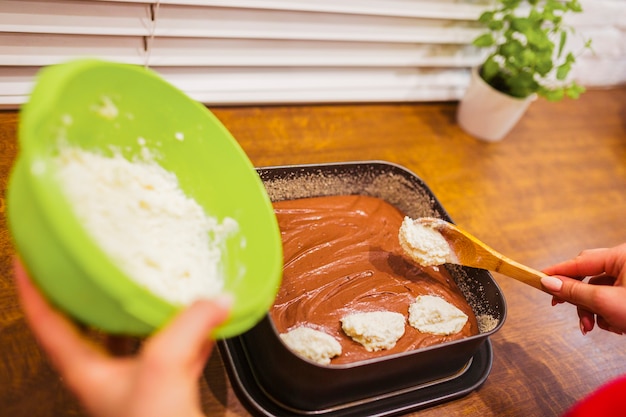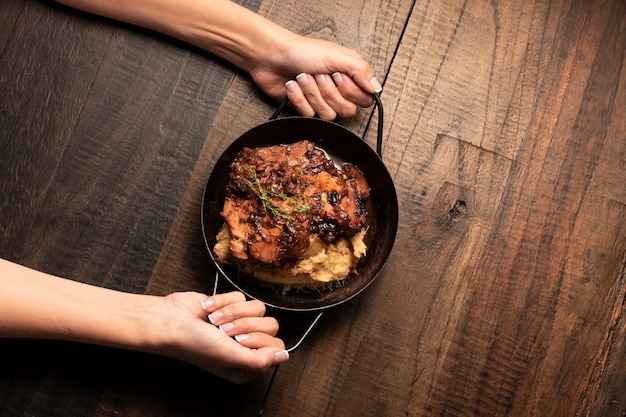There's something truly magical about Korean barbecue. The sizzle of the meat, the explosion of flavours, and the communal joy of sharing a feast – it's an experience that has captivated me ever since my first taste. Years ago, I had the opportunity to visit Seoul, the heart of Korean culture, and experience bulgogi in its truest form. It was a revelation! From the vibrant street food stalls to the upscale restaurants, the sheer variety and quality of the dishes blew me away.
But you don't need a plane ticket to Seoul to enjoy this culinary delight. With a bit of know-how and the right ingredients, you can recreate this vibrant experience right in your own kitchen. So, put on your apron, grab your chopsticks, and get ready to embark on a flavourful journey with me. I'll guide you through every step, share my tips and tricks, and hopefully, by the end of this, you'll be a bulgogi pro yourself!
(Part 1) The Magic of Marinades: Unveiling the Essence of Flavor

The heart and soul of bulgogi lies in its marinade. It's not just about adding flavour; it's about transforming the meat into a tender, juicy masterpiece. A traditional bulgogi marinade is a harmonious blend of sweet, salty, savoury, and a subtle hint of spice, creating a symphony of flavour that dances on your palate.
A Symphony of Flavors: Decoding the Ingredients
Think of the marinade as a love letter to the meat, showering it with the best of flavours. Each ingredient plays a crucial role in crafting the perfect bulgogi experience. Here's a closer look at the key players:
- Soy sauce: The cornerstone of the marinade, it provides the salty, umami flavour that defines bulgogi. This is not just any soy sauce; Korean soy sauce, known for its darker colour and saltier profile, is the ideal choice for that authentic depth of flavour.
- Sugar: Adds a touch of sweetness, balancing the saltiness and creating a delicious contrast. This can be regular white sugar, brown sugar, or even honey, depending on your preference. Just remember to adjust the amount based on the sweetness of your chosen sugar.
- Garlic: A flavour powerhouse, garlic contributes a pungent aroma and a robust savoury depth. The amount of garlic can be adjusted to your taste, but a generous amount is usually recommended for a truly authentic bulgogi experience.
- Ginger: Adding a subtle warmth and a hint of citrusy zest, ginger complements the garlic perfectly, creating a harmonious flavour profile. Freshly grated ginger is always preferred, but you can also use ground ginger if needed.
- Sesame oil: This ingredient adds a nutty aroma and a silky texture, enhancing the overall flavour and giving the marinade a luxurious touch. Look for high-quality sesame oil, as it will make a significant difference in the final flavour.
- Korean pear juice: A hidden gem in the bulgogi marinade, Korean pear juice adds a subtle sweetness and acts as a natural tenderizer, ensuring the meat remains juicy and tender. You can find Korean pears at most Asian grocery stores, and the juice can be extracted at home or purchased pre-made.
- Black pepper: A touch of spice, black pepper adds a subtle heat and a hint of complexity, balancing the sweetness and saltiness of the marinade. Freshly ground black pepper is always preferred for a more robust flavour.
- Green onions: They add a fresh, slightly sweet flavour and a touch of crunch, offering a vibrant contrast to the rich marinade. Use the entire green onion, both the white and green parts, for the best flavour.
My marinade: A little twist on tradition
Now, I'm not one to shy away from a little culinary exploration. While I hold the classic bulgogi marinade in high regard, I've been known to add a touch of my own creativity. For a bit of extra heat, I like to add a tablespoon of gochujang, a Korean chili paste, which brings a fiery kick to the party. And sometimes, for a citrusy twist, I'll squeeze in a little lime juice, adding a refreshing brightness to the marinade. It's all about finding the perfect flavour balance that sings to your taste buds!
(Part 2) choosing the right cut: The Foundation of a Delicious Bulgogi

The quality of the meat is just as important as the marinade. While a tough cut can be tenderized by the magic of the marinade, you'll get the best results with a cut that's naturally tender. This is where understanding the different cuts of meat comes into play.
beef cuts for Bulgogi: A Guide to Tenderness and Flavor
Traditionally, bulgogi is made with thinly sliced beef, and here are some excellent options for a truly delicious experience:
- Brisket: A classic choice, brisket is known for its rich flavour and tenderness when cooked properly. The key is to choose a well-marbled brisket, which will render fat during cooking, resulting in a succulent and juicy experience.
- Short rib: Marbled with fat, short rib adds a delightful richness to the bulgogi, melting in your mouth with each bite. It's a luxurious choice, offering a symphony of flavours and textures.
- flank steak: A leaner option, flank steak is still flavourful and tender when thinly sliced. The key is to cook it quickly, ensuring it remains juicy and tender.
- Sirloin: A versatile cut, sirloin offers a good balance of flavour and tenderness, making it a reliable choice for bulgogi. Choose a well-marbled sirloin for the best results.
Beyond Beef: Exploring Other Protein Options
While beef reigns supreme in the world of bulgogi, you can also explore other protein options for a unique twist on the classic. Here are some delicious alternatives:
- Pork: Choose a leaner cut, like pork tenderloin or loin, for a delicate and flavourful bulgogi experience. These cuts cook quickly and remain juicy, offering a lighter alternative to beef.
- Chicken: Thinly sliced chicken breast or thighs are perfect for bulgogi, ensuring a quick cook and juicy results. The chicken absorbs the marinade beautifully, creating a flavourful and satisfying dish.
The choice is ultimately yours. Experiment and discover the protein that speaks to your taste buds!
(Part 3) The Art of Thin Slicing: Unveiling the Secrets to a Tender Bulgogi

The key to a perfect bulgoki lies in the art of thin slicing. Thinly sliced meat cooks faster and more evenly, resulting in juicy, tender bites that melt in your mouth. Now, I'm no butcher, but I've picked up a few tricks over the years to ensure my bulgogi is always perfectly sliced.
Freezing for Easier Slicing: A Simple Trick for Perfect Results
One of my favourite tricks is to freeze the meat for about 30 minutes before slicing. This makes it easier to slice thinly and prevents the meat from tearing. Just make sure to take it out of the freezer a few minutes before you're ready to slice so it's not completely frozen solid.
A Sharp Knife is Key: The Foundation of Precision
A sharp knife is absolutely essential for achieving those razor-thin slices. If your knife is dull, you'll end up with uneven and thick slices, which won't cook as evenly. I recommend using a slicing knife, a chef's knife with a thin blade, or even a meat cleaver if you're feeling ambitious. And remember, safety first! Always use a cutting board and keep your fingers away from the blade.
(Part 4) Marinating for Maximum Flavor: Letting the Meat Absorb the Essence of the Marinade
Once you've got your thinly sliced meat, it's time to let it soak up all the delicious flavours of the marinade. The longer you marinate it, the more intense the flavour will be, but a minimum of 30 minutes is essential for the marinade to penetrate the meat and create a symphony of taste.
The Perfect Marinade Time: Finding the Balance Between Flavor and Tenderness
Here's a general rule of thumb for marinating your bulgogi:
- 30 minutes: A good starting point, allowing the marinade to infuse the meat with a base of flavour. This is a good option if you're short on time.
- 1-2 hours: The ideal time for a rich and balanced flavour profile, allowing the marinade to fully penetrate the meat. This is my go-to marinating time for a perfectly balanced bulgogi experience.
- Overnight: For the ultimate flavour bomb, marinate overnight in the refrigerator. This allows the marinade to work its magic, creating an intense and complex flavour that will truly impress your taste buds.
Just remember, if you're marinating for longer than a few hours, make sure to keep the meat in the refrigerator to prevent bacterial growth.
(Part 5) Cooking the Bulgogi: Grilling to Perfection
There's nothing quite like the sound of bulgogi sizzling on a hot grill. It's a symphony of flavour and a visual feast, and it's what makes Korean barbecue so captivating. The grilling process is where the magic really happens, transforming the marinated meat into a culinary masterpiece.
Grilling on a Flat Top Grill: The Ideal Choice for Even Cooking
If you have a flat top grill, that's your best bet for cooking bulgogi. It allows for even heat distribution, ensuring the meat cooks evenly and doesn't dry out. Heat the grill to medium-high heat and lightly oil it. Then, place the marinated meat strips on the grill, making sure not to overcrowd the surface. This will allow the meat to cook properly and develop those beautiful grill marks.
Grilling on a Regular Grill: Tips for Success
You can also cook bulgogi on a regular grill, but be sure to use a grill pan or a grill rack to prevent the meat from falling through the grates. The key is to cook the meat over medium-high heat for 2-3 minutes per side, until it's nicely browned and cooked through. Avoid overcooking, as this can lead to dryness.
Pan-Frying for a Quick and Easy Option: Perfect for weeknight dinners
If you don't have a grill, you can always pan-fry the bulgogi. Just heat a little oil in a large skillet over medium-high heat and cook the meat strips for 2-3 minutes per side. Make sure to stir frequently to ensure even cooking and prevent sticking.
(Part 6) Perfecting the Sides: A Culinary Symphony of Flavors and Textures
Bulgogi is a culinary experience that's best enjoyed with a symphony of sides. These accompaniments play a vital role in complementing the bold flavours of the bulgogi and creating a harmonious feast. They offer a variety of textures and tastes, enhancing the overall dining experience.
Essential side dishes: Completing the Korean BBQ Experience
- Kimchi: A fermented cabbage dish that adds a spicy and tangy kick to the meal. Kimchi is a staple in Korean cuisine, and its unique flavour perfectly balances the richness of the bulgogi. It's a must-have for any authentic Korean barbecue experience!
- Lettuce wraps: Fresh lettuce leaves provide a crisp and refreshing element, perfect for wrapping up juicy bulgogi bites. Lettuce wraps allow you to customize your bites, creating a unique combination of flavours and textures.
- Rice: A simple yet essential side dish that provides a neutral base for all the bold flavours. Rice absorbs the juices from the bulgogi and the sauces, creating a harmonious and satisfying meal.
- Pickled vegetables: They add a tangy and crunchy element, balancing the richness of the bulgogi and adding a refreshing contrast. Pickled vegetables offer a burst of flavour and texture, making each bite a delightful adventure.
- Spicy gochujang sauce: A dipping sauce that adds a fiery kick to the bulgogi. Gochujang sauce is a Korean chili paste that adds a depth of flavour and a touch of heat, perfectly complementing the bulgogi.
My Personal Favourites: Adding a Touch of Variety to the Feast
I love to have a variety of sides on hand, and here are a few of my personal favourites that elevate the bulgogi experience:
- Japchae: A delicious stir-fried noodle dish that's full of flavour and texture. Japchae is a colourful and satisfying dish, offering a unique blend of sweet, savoury, and umami flavours.
- Bibimbap: A mixed rice dish with vegetables, meat, and a fried egg, offering a colourful and satisfying meal. Bibimbap is a complete meal in a bowl, combining the freshness of vegetables, the richness of meat, and the creamy goodness of a fried egg.
- Korean pancakes (Pajeon): These savoury pancakes are often filled with seafood, kimchi, or vegetables, and they add a delightful crunch to the meal. Pajeon is a crispy and flavourful addition to the bulgogi experience, offering a contrast in texture and taste.
(Part 7) Putting it all Together: The Complete Bulgogi Experience
Now, it's time to assemble the grand finale! The best part about bulgogi is that it's all about sharing and enjoying the experience with loved ones. It's a meal that brings people together, fostering laughter, conversation, and the joy of shared culinary adventures.
Setting the Scene: Creating a Culinary Atmosphere
Think about setting the mood. Dim the lights, put on some Korean music, and create a warm and inviting atmosphere. You can even set up a DIY Korean barbecue station with various side dishes and dipping sauces, allowing guests to customize their experience. This creates a fun and interactive dining experience, bringing everyone into the heart of the Korean barbecue tradition.
The Final Touch: Assembling the Culinary Masterpiece
Once the bulgogi is cooked to perfection, it's time to assemble your masterpiece. Arrange your side dishes, pour yourself a glass of soju or makgeolli (Korean rice wine), and let the feast begin! The combination of flavours, textures, and aromas will create a symphony of taste that will leave you craving for more.
Don't Forget the Ssam: A Traditional Way to Enjoy Bulgogi
A true Korean barbecue experience involves creating ssam, which are lettuce wraps filled with bulgogi, kimchi, and other ingredients. It's a delicious way to enjoy all the flavours together and create your own personalised bites! This interactive and playful element adds a touch of fun and excitement to the meal, making it a truly unique experience.
(Part 8) FAQs: Your Bulgogi Questions Answered
1. What kind of soy sauce should I use?
For the most authentic flavour, use Korean soy sauce. It's often darker and saltier than regular soy sauce, giving the bulgogi that distinctive umami flavour that sets it apart. You can find Korean soy sauce at most Asian grocery stores.
2. Can I use a different type of sugar?
Yes, you can use brown sugar, honey, or even maple syrup instead of regular white sugar. Just remember to adjust the amount depending on the sweetness of your chosen substitute. Brown sugar adds a warm caramel flavour, honey provides a delicate sweetness, and maple syrup offers a rich and complex sweetness. Experiment and find the sugar that best complements your taste.
3. How do I know when the bulgogi is cooked through?
The meat should be cooked to an internal temperature of 145 degrees Fahrenheit (63 degrees Celsius) for beef, 160 degrees Fahrenheit (71 degrees Celsius) for pork, and 165 degrees Fahrenheit (74 degrees Celsius) for chicken. If you're not sure, you can use a meat thermometer to check. Avoid overcooking, as this will result in dry and tough meat.
4. Can I make bulgogi ahead of time?
Yes, you can make bulgogi ahead of time and store it in the refrigerator for up to 2 days. Just reheat it gently over low heat before serving. This is a great option for busy weeknights or when you want to prep ahead for a party.
5. Where can I find Korean ingredients?
You can find Korean ingredients at Asian grocery stores or online retailers. Many supermarkets also carry a small selection of Korean ingredients, especially in areas with a large Asian population. Don't be afraid to ask for help from the staff if you can't find something. They are usually happy to assist you in finding the ingredients you need.
And there you have it! My guide to making authentic bulgogi at home. I hope you enjoyed this culinary adventure with me. Remember, don't be afraid to experiment and find your own perfect flavour combinations. Happy grilling!
Everyone is watching

How to Cook Frozen Lobster Tails Perfectly: A Step-by-Step Guide
RecipesLobster. Just the word conjures up images of lavish meals, special occasions, and a taste of luxury. But let's...

Pigs in a Blanket Cooking Time: How Long to Bake for Perfect Results
RecipesAh, pigs in a blanket. Just the name conjures up images of those delightful little parcels of crispy pastry en...

Pork Fillet Cooking Time: How Long to Cook It Perfectly
RecipesPork fillet, or tenderloin as it's sometimes called, is a real favourite in our house. It's so versatile, and...

The Ultimate Guide to Tender, Juicy Pulled Pork
RecipesRight, let's talk pulled pork. It's one of those dishes that just screams "comfort food," doesn't it? I mean...

The Ultimate Guide to Cooking Sweet Potatoes: From Roasting to Mashing
RecipesSweet potatoes. Just the name conjures up images of warm, comforting dishes, bursts of vibrant color, and a to...
